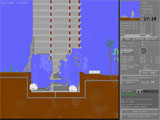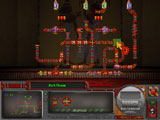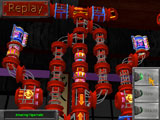Brilliant, Addicting Rope Game: Zen Bondage
The concept of Zen Bondage is simplistic: Wrap rope around a block of wood. The implementation, though, is damn near flawless. I would be hard-pressed to find something to improve.
Physics Simulation
Zen Bondage isn’t a physics game in the typical sense of object dynamics. The game has nothing to do with inertia, forces, and gravity. Instead, it simulates a very narrow piece of reality–tying rope around an object. It does this very, very well. The goal of the game is to completely cover entire object with rope. Colored paint emanates from the rope to visually represent your progress. The trick is in covering the concave areas. For instance, if you accidentally span a gap with rope there isn’t any way to thread through the newly-created tunnel.
Rope Controls
Zen Bondage utilizes the Arcball technique to rotate the target object. For me, this was very intuitive. I’d be interested to see how well someone off the street–who’s never used 3D applications before–could handle the game. I suspect they could still play, although probably much more clumsily.
If you do make a mistake, you can simply unwind your object to bring the last rope connection point so it’s forward-facing. I’ve seen the rope get slightly “sticky” at times, where it doesn’t want to let go, but for the most part the game behaves exactly as you expect it would.
And that’s just what makes Zen Bondage so appealing–it does behave as expected. You’re never fighting the interface or the technology. There are a lot of very clever things going on behind the scenes to mask complexity from the user. It’s a very polished user experience. The visuals are clean and the audio complements the theme perfectly.
What About a Full Simulation?
The physics simulation in Zen Bondage is rather abstracted. It would be interesting to see the same concept implemented in a full physics engine. With something like AGEIA’s PhysX hardware you could easily simulate the rope to a very high degree of fidelity. Ironically, it would probably make the game more frustration than fun, as rope already laid down would shift around. It would make for a good study. Idealized reality tends to be much more enjoyable than reality itself.


(Zen Bondage Game Screenshots)
It’s Free
Zen Bondage was developed by Moppi Productions, a small team active in the demo scene (they’ve produced a number of demos for parties such as Assembly). Zen Bondage is freeware.
Download Zen Bondage game here (23.2 MB).
Related Posts:
The Most Innovative Physics Game since Bridge Builder?
Operation Cleaner 2 could very well be the best physics game I’ve played in months. Unfortunately, the operative word in that sentence is could. Its tremendous potential is hampered by clunky implementation. The premise of the game is brilliant: You operate a demolitions company. Naturally, the game is all about demolishing buildings. You choose the type and placement of explosives, configuration of your workforce, and select the type of jobs you’re most suited for. It sounds like a blast!
Make a Career of It
While Operation Cleaner 2 does have a quick play mode, which randomly generates maps, the meat of the game is in the career mode. Your business starts in a fictional city, where you begin by destroying relatively easy buildings. These buildings are fairly small, requiring a simple series of explosives, with ample spacing around them. Accidentally damaging other buildings will cost your bottom line dearly.
Each city has 14 buildings. Once you finish up one city, you must pay a hefty fee to move to another city with larger, more tightly-spaced buildings. The densely-packed cities are a lot more interesting, but also much more dangerous. A single botched job can bankrupt you in one fell swoop.
Simulation Management
In addition to the obvious physics simulation of buildings being torn apart by dynamite, TNT, and C4, there is a layer of business simulation in Operation Cleaner 2. You can select the number of workers, elevators, bulldozers, and guards for you team on the ground. More workers means faster setup times and faster cleanup times, but your daily burn rate goes up significantly. You can even adjust sliders for your collateral damage insurance, tax evasion, and the quality of your accountant, all of which affects your reputation rating. The level of detail is almost neurotic. The developer actually works as a government bureaucrat, which might explain a few things.
The explosion simulation is fairly robust. While it doesn’t do much structural simulation–you can have an entire building held up by one tile–it does a good job of simulation the fun stuff: The explosions. Pressure waves will channel through weak areas of the building, and you can stagger your explosions to maximize the effect. If you aren’t careful and put a little too much C4 in a small structure, though, you can very easily rake the side of a nearby building. Oops.
So What’s Not to Like?
Operational Cleaner 2 is about blowing stuff up. As a player, that sounds fantastic; I like destroying things. The problem with Operation Cleaner is that it makes the whole blowing-stuff-up process extremely frustrating. The user interface is anything but friendly. I couldn’t figure out how to play the game without first reading through the HTML manual.
Masochist Difficulty
The game is way too hard. It’s very difficult to make a profit on most of the jobs. And by the end of a city you’ll need at least $10,000 to move to another town. Perhaps I’m missing some vital detonation technique, here, but there’s no way I could earn that kind of money with the game’s current balancing.
The original Operation Cleaner game was released in 1998. I suspect the developer, Jan Nyman, and his beta testers are simply too damn good at the game by now. In fact, if you look at the revision history you’ll see stuff like this listed as “improvements”:
- Placing dampers increases readying time
- Directed explosions are even more expensive and take longer readying time
- Payments are smaller, especially in larger buildings
These so-called improvements simply make the game harder. Perhaps it’s an improvement for their experience of the game, sure, but for a first-time player they’re cutthroat changes. In my opinion, the difficulty curve should be much gentler. The first city should almost be too easy. New players have more fun than frustration. It shouldn’t take dozens of tries to make a profit on the first three buildings.


(Operation Cleaner 2 Game Screenshots)
Changing a Few Things
I want to enjoy Operation Cleaner 2. Really, I do. But the game just won’t stand for it. You really have to work to eek enjoyment out of the game, which is a damn shame. The concept is too awesome to suffer from implementation problems that could easily be remedied. Luckily, Jan has generously posted the source code for the game. I went ahead and rebalanced things to make the game easier. In my version, explosives are more powerful, dampers are much cheaper (although accidental damage to other buildings is more costly), and contracts are worth more. Now I can actually play career mode past the first city.
Download Information for Operation Cleaner 2
Operation Cleaner 2 is freeware. The original game is still available, too, although it’s an old DOS game. It may or may not run too well in Windows XP (I haven’t tried it, but DOSBox could be a solution if anyone is interested). The source code for the game is also available.
Download Operation Cleaner 2 game (3.49 MB).
My alternative easier version is here (copy this EXE to your game directory).
Related Posts:
- List of Physics Games
- Throw Metal Pies at Ragdoll Clowns (Redux)
- Pummel Ragdoll Clowns (Right in Your Web Browser!)
- Interview with Matthew Wegner (Fun-Motion.com)
Let’s Twist Again: TubeTwist
TubeTwist is great hybrid puzzle-y physics game by 21-6 Productions, best known for their Orbz title, and distributed by GarageGames. The product page describes TubeTwist as follows:
TubeTwist is a puzzle game fashioned after classics like The Incredible Machine and Mouse Trap. Each experiment has many solutions due to the large variety of tubes which can be used to construct each machine. There is no clock and there is no score – so just sit back and enjoy the mind bending fun that is TubeTwist!
It’s Thinking Time
The goal of TubeTwist is deceptively simple. Colored balls start in one tube, and it’s your job as the player to ensure they wind up in a colored end tubes. Each level has a starting layout. In addition to the default pieces, you’re given a limited number of pieces to place wherever you choose. You can use these pieces to bridge gaps in the default layout or to create your own path. I’ve actually solved levels where I don’t even touch the starting layout.
While the goal is obvious enough, the game’s complexity arises through two mechanisms: scarcity and object states.
Piece Scarcity
Some levels are difficult because of the scarcity of the pieces available to the player. You’re given a handful of tubes, at best–certainly not enough pieces to go from point A to point B continuously. These levels force you to rely on the physics of the ball. Inertia can be your friend; if the ball is going fast enough, you don’t need a contiguous pathway. Rather, you could have a few holes and the ball will zip over the gaps without any trouble. Or if you’re feeling especially spicy, you can actually try to launch a ball quite some distance into a tube (the video has an example of this). Accelerator tubes speed the ball up. Careful placement allows you to regulate the ball’s velocity with a fair degree of control, allowing for crafty gap jumps.
Object States
This is where TubeTwist shows its puzzle origins. Many of the tubes have states associated with them. Some tubes toggle their direction after a ball passes through them, while others are physics contraptions in and of themselves. Still other tubes modify the state of the ball–toggling between a gravity-free version and the normal clunky ball.
Depending on how receptive you are to feeling like a complete idiot, you may find the puzzle aspects of TubeTwist frustrating. Typically the levels force you to regulate the order in which things happen. If you need ball A to pass through a tube before ball B gets there, you’ll need to find some way to slow it down. It can get awfully hairy when later levels have upwards of half a dozen switches.
Yet More Complexity
The game also introduces checkpoints in later levels. Rather than simply get the ball from the start to the goal, you need to activate all the checkpoints first. And I did I mention that some levels have half a dozen starting points all spewing balls simultaneously? Later levels really lay on the brain-hurt awfully thick. The game forces you to manage a large number of events in a particular order to pass the stage.
Physics to the Rescue
If TubeTwist were simply a puzzle game, I probably wouldn’t play it. I’m not a big fan of logic puzzles, to be honest (maybe I’m just not very good at them). But because TubeTwist is physics-based, though, I really find myself enjoying it. The physics, coupled with the large number of tubes, means that any one level has a number of solutions available. Some of the solutions are obviously the designer’s intent, while others may be completely new.
Physics do a great job of managing the complexity of what would otherwise be a completely overwhelming puzzle game. It’s a very approachable design. You simply run the machine, note where balls are failing, and make iterative adjustments. Because everything follows the intuitive nature of physics, nothing is ever too confusing.
“PassagePeculiarity” Just Didn’t Have the Same Ring
21-6 Productions managed to use physics to great effect and produced a title that’s challenging yet approachable. I have no idea how well the game is selling, but TubeTwist has already picked up an IGF nomination and finalist status in the ECD Systems Indie Games Showcase. If you happen to be going to E3 this year, swing by booth #6453 in Kentia Hall. As a bonus, I’ll be alongside TubeTwist in the showcase demoing our next Flashbang game.
A free demo of TubeTwist is available from the GarageGames website. The full version costs $19.95.
Related Posts:
« Previous Page — Next Page »


 (Rate this game! 138 votes, average: 3.70 out of 5)
(Rate this game! 138 votes, average: 3.70 out of 5)

 My name is Matthew Wegner, and this site is dedicated to physics games.
My name is Matthew Wegner, and this site is dedicated to physics games.